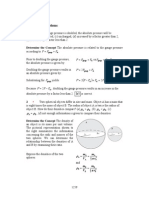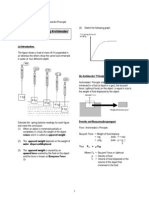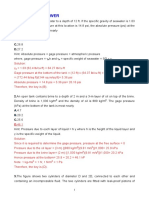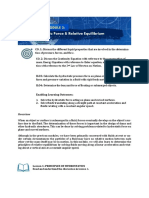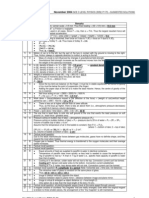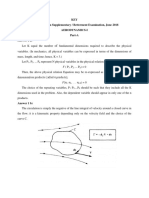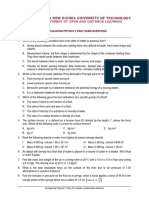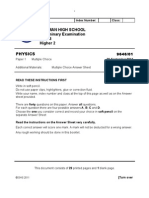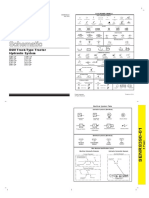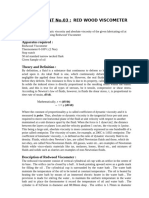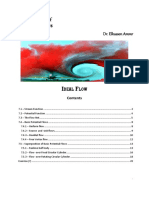Ch13 SSM
Ch13 SSM
Uploaded by
Juanca AbadCopyright:
Available Formats
Ch13 SSM
Ch13 SSM
Uploaded by
Juanca AbadOriginal Title
Copyright
Available Formats
Share this document
Did you find this document useful?
Is this content inappropriate?
Copyright:
Available Formats
Ch13 SSM
Ch13 SSM
Uploaded by
Juanca AbadCopyright:
Available Formats
Chapter 13
Fluids
Conceptual Problems
3 Two objects differ in density and mass. Object A has a mass that is
eight times the mass of object B. The density of object A is four times the density
of object B. How do their volumes compare? (a)
B 2
1
A
V V = , (b) V
A
= V
B
,
(c) V
A
= 2V
B
, (d) not enough information is given to compare their volumes.
Determine the Concept The density of an object is its mass per unit volume. We
can determine the relationship between the volumes of A and B by examining
their ratio.
Express the volumes of the two
objects:
A
A
A
m
V = and
B
B
B
m
V =
Divide the first of these equations by
the second and simplify to obtain:
B
A
A
B
B
B
A
A
B
A
m
m
m
m
V
V
= =
Substituting for the masses and
densities and simplifying yields:
2
8
4
B
B
B
B
B
A
= =
m
m
V
V
B A
2V V =
and ( ) c is correct.
7 A solid 200-g block of lead and a solid 200-g block of copper are
completely submerged in an aquarium filled with water. Each block is suspended
just above the bottom of the aquarium by a thread. Which of the following is true?
(a) The buoyant force on the lead block is greater than the buoyant force on the
copper block.
(b) The buoyant force on the copper block is greater than the buoyant force on
the lead block.
(c) The buoyant force is the same on both blocks.
(d) More information is needed to choose the correct answer.
Determine the Concept The buoyant forces acting on these submerged objects
are equal to the weight of the water each displaces. The weight of the displaced
water, in turn, is directly proportional to the volume of the submerged object.
Because
Pb
>
Cu
, the volume of the copper must be greater than that of the lead
and, hence, the buoyant force on the copper is greater than that on the lead.
) (b is correct.
267
Chapter 13
268
13 An upright glass of water is accelerating to the right along a flat,
horizontal surface. What is the origin of the force that produces the acceleration
on a small element of water in the middle of the glass? Explain by using a
diagram. Hint: The water surface will not remain level as long as the glass of
water is accelerating. Draw a free body diagram of the small element of water.
Determine the Concept The pictorial
representation shows the glass and an
element of water in the middle of the
glass. As is readily established by a
simple demonstration, the surface of
the water is not level while the glass is
accelerated, showing that there is a
pressure gradient (a difference in
pressure) due to the differing depths
(h
1
> h
2
and hence F
1
> F
2
) of water on
the two sides of the element of water.
This pressure gradient results in a net
force on the element as shown in the
figure. The upward buoyant force is
equal in magnitude to the downward
gravitational force.
1
h
2
h
2
F
1
F
g
F
b
F
17 Figure 13-30 is a diagram of a prairie dog tunnel. The geometry of the
two entrances are such that entrance 1 is surrounded by a mound and entrance 2 is
surrounded by flat ground. Explain how the tunnel remains ventilated, and
indicate in which direction air will flow through the tunnel.
Determine the Concept The mounding around entrance 1 will cause the
streamlines to curve concave downward over the entrance. An upward pressure
gradient produces the downward centripetal force. This means there is a lowering
of the pressure at entrance 1. No such lowering occurs aver entrance 2, so the
pressure there is higher than the pressure at entrance 1. The air circulates in
entrance 2 and out entrance 1. It has been demonstrated that enough air will
circulate inside the tunnel even with slightest breeze outside.
Density
21 Consider a room measuring 4.0 m 5.0 m 4.0 m. Under normal
atmospheric conditions at Earths surface, what would be the mass of the air in
the room?
Picture the Problem The mass of the air in the room is the product of its density
and volume. The density of air can be found in Figure 13-1.
Fluids
269
Use the definition of density to
express the mass of the air in the
room:
LWH V m = =
Substitute numerical values and
evaluate m:
( )( )( )( )
kg 10 0 . 1
m 4.0 m 5.0 m 0 . 4 kg/m 293 . 1
2
3
=
= m
Pressure
31 A hydraulic lift is used to raise a 1500-kg automobile. The radius of
the shaft of the lift is 8.00 cm and the radius of the compressors piston is
1.00 cm. How much force must be applied to the piston to raise the automobile?
Hint: The shaft of the lift is the other piston.
Picture the Problem The pressure applied to an enclosed liquid is transmitted
undiminished to every point in the fluid and to the walls of the container. Hence
we can equate the pressure produced by the force applied to the piston to the
pressure due to the weight of the automobile and solve for F.
Express the pressure the weight of
the automobile exerts on the shaft of
the lift:
shaft
auto
auto
A
w
P =
Express the pressure the force
applied to the piston produces:
piston
A
F
P =
Because the pressures are the same,
we can equate them to obtain:
piston shaft
auto
A
F
A
w
=
Solving for F yields:
shaft
piston
auto
shaft
piston
auto
A
A
g m
A
A
w F = =
Substitute numerical values and
evaluate F:
( )( )
N 230
cm 8.00
cm 1.00
m/s 9.81 kg 1500
2
2
=
= F
Chapter 13
270
Buoyancy
43 A block of an unknown material weighs 5.00 N in air and 4.55 N when
submerged in water. (a) What is the density of the material? (b) From what
material is the block likely to have been made?
Picture the Problem We can use the definition of density and Archimedes
principle to find the density of the unknown object. The difference between the
weight of the object in air and in water is the buoyant force acting on the object.
(a) Using its definition, express the
density of the object:
object
object
object
V
m
= (1)
Apply Archimedes principle to
obtain:
g V
g m w B
fluid
displaced
fluid
displaced
fluid
displaced
fluid
displaced
=
= =
Solve for :
fluid
displaced
V
g
B
V
fluid
displaced
fluid
displaced
=
Because and
object
fluid
displaced
V V =
water
fluid
displaced
= :
g
B
V
water
object
=
Substitute in equation (1) and
simplify to obtain:
water
object
water
object
object
B
w
B
g m
= =
Substitute numerical values and evaluate
object
:
( )
3 3 3 3
object
kg/m 10 11 kg/m 10 00 . 1
N 4.55 N 00 . 5
N 00 . 5
=
=
(b) From Table 13-1, we see that the density of the unknown material is close to
that of lead.
49 An object has neutral buoyancy when its density equals that of the
liquid in which it is submerged, which means that it neither floats nor sinks. If the
average density of an 85-kg diver is 0.96 kg/L, what mass of lead should, as dive
master, suggest be added to give him neutral buoyancy?
Fluids
271
Picture the Problem Let V = volume of diver,
D
the density of the diver, V
Pb
the
volume of added lead, and m
Pb
the mass of lead. The diver is in equilibrium under
the influence of his weight, the weight of the lead, and the buoyant force of the
water.
Apply to the diver:
= 0
y
F 0
Pb D
= w w B
Substitute to obtain: 0
Pb D D Pb D w
=
+
g m g V g V
or
0
Pb D D Pb w D w
= + m V V V
Rewrite this expression in terms
of masses and densities:
0
Pb
D
D
D
Pb
Pb
w
D
D
w
= + m
m m m
Solving for m
Pb
yields:
( )
( )
w Pb D
D D w Pb
Pb
=
m
m
Substitute numerical values and evaluate m
Pb
:
( )( )( )
( )( )
kg 9 . 3
kg/m 10 00 . 1 kg/m 10 11.3 kg/m 10 0.96
kg 85 kg/m 10 0.96 kg/m 10 00 . 1 kg/m 10 11.3
3 3 3 3 3 3
3 3 3 3 3 3
Pb
=
= m
53 A ship sails from seawater (specific gravity 1.025) into freshwater, and
therefore sinks slightly. When its 600,000-kg load is removed, it returns to its
original level. Assuming that the sides of the ship are vertical at the water line,
find the mass of the ship before it was unloaded.
Picture the Problem Let V = displacement of ship in the two cases, m be the
mass of ship without load, and m be the load. The ship is in equilibrium under
the influence of the buoyant force exerted by the water and its weight. Well
apply the condition for floating in the two cases and solve the equations
simultaneously to determine the loaded mass of the ship.
Apply to the ship in fresh
water:
= 0
y
F
0
w
= mg Vg (1)
Apply to the ship in salt
water:
= 0
y
F
( ) 0
sw
= + g m m Vg (2)
Solve equation (1) for Vg:
w
mg
Vg =
Chapter 13
272
Substitute in equation (2) to obtain:
( ) 0
w
sw
= + g m m
mg
Solving for m yields:
w sw
w
=
m
m
Add m to both sides of the equation
and simplify to obtain:
w sw
sw
w sw
w
w sw
w
1
=
+
= +
m
m
m
m
m m
Substitute numerical values and
evaluate m + m:
( )( )
( )( )
kg 10 5 . 2
1 025 . 1
025 . 1 kg 10 00 . 6
025 . 1
025 . 1 kg 10 00 . 6
7
5
w w
w
5
=
= +
m m
Continuity and Bernoulli's Equation
55 Water is flowing at 3.00 m/s in a horizontal pipe under a pressure of
200 kPa. The pipe narrows to half its original diameter. (a) What is the speed of
flow in the narrow section? (b) What is the pressure in the narrow section?
(c) How do the volume flow rates in the two sections compare?
Picture the Problem Let A
1
represent the cross-sectional area of the larger-
diameter pipe, A
2
the cross-sectional area of the smaller-diameter pipe, v
1
the
speed of the water in the larger-diameter pipe, and v
2
the velocity of the water in
the smaller-diameter pipe. We can use the continuity equation to find v
2
and
Bernoullis equation for constant elevation to find the pressure in the smaller-
diameter pipe.
(a) Using the continuity equation,
relate the velocities of the water to
the diameters of the pipe:
2 2 1 1
v A v A =
or
2
2
2
1
2
1
4 4
v
d
v
d
=
1 2
2
2
1
2
v
d
d
v =
Fluids
273
Substitute numerical values and
evaluate v
2
:
( ) m/s 0 . 12 m/s 3.00
2
1 2
1
1
2
=
=
d
d
v
(b) Using Bernoullis equation for
constant elevation, relate the
pressures in the two segments of the
pipe to the velocities of the water in
these segments:
2
2 w 2
1
2
2
1 w 2
1
1
v P v P + = +
Solving for P
2
yields:
( )
2
2
2
1 w 2
1
1
2
2 w 2
1
2
1 w 2
1
1 2
v v P
v v P P
+ =
+ =
Substitute numerical values and evaluate P
2
:
( )( ) ( ) [ ] kPa 133 m/s 0 . 12 m/s 00 . 3 kg/m 10 00 . 1 kPa 200
2 2 3 3
2
1
2
= + = P
(c) From the continuity equation;
V2 V1
I I = .
57 Blood flows at at 30 cm/s in an aorta of radius 9.0 mm. (a) Calculate
the volume flow rate in liters per minute. (b) Although the cross-sectional area of
a capillary is much smaller than that of the aorta, there are many capillaries, so
their total cross-sectional area is much larger. If all the blood from the aorta flows
into the capillaries and the speed of flow through the capillaries is 1.0 mm/s,
calculate the total cross-sectional area of the capillaries. Assume laminar
nonviscous, steady-state flow.
Picture the Problem We can use the definition of the volume flow rate to find
the volume flow rate of blood in an aorta and to find the total cross-sectional area
of the capillaries.
(a) Use the definition of the volume
flow rate to find the volume flow
rate through an aorta:
Av I =
V
Substitute numerical values and
evaluate I
V
:
( ) ( )
L/min 6 . 4 L/min 58 . 4
m 10
L 1
min
s 60
s
m
10 634 . 7
m/s 30 . 0 m 10 0 . 9
3 3
3
5
2
3
V
= =
=
=
I
Chapter 13
274
(b) Use the definition of the volume
flow rate to express the volume
flow rate through the capillaries:
cap cap V
v A I =
cap
V
cap
v
I
A =
Substitute numerical values and
evaluate A
cap
:
2 2
3 5
cap
m 10 7.6
m/s 0010 . 0
/s m 10 7.63
= A
61 Horizontal flexible tubing for carrying cooling water extends through a
large electromagnet used in your physics experiment at Fermi National
Accelerator Laboratory. A minimum volume flow rate of 0.050 L/s through the
tubing is necessary in order to keep your magnet cool. Within the magnet volume,
the tubing has a circular cross section of radius 0.500 cm. In regions outside the
magnet, the tubing widens to a radius of 1.25 cm. You have attached pressure
sensors to measure differences in pressure between the 0.500 cm and 1.25 cm
sections. The lab technicians tell you that if the flow rate in the system drops
below 0.050 L/s, the magnet is in danger of overheating and that you should
install an alarm to sound a warning when the flow rate drops below that level.
What is the critical pressure difference at which you should program the sensors
to send the alarm signal (and is this a minimum, or maximum, pressure
difference)? Assume laminar nonviscous steady-state flow.
Picture the Problem The pictorial representation shows the narrowing of the
cold-water supply tubes as they enter the magnet. We can apply Bernoullis
equation and the continuity equation to derive an expression for the pressure
difference P
1
P
2
.
cm 50 . 2
1
= d cm 000 . 1
2
= d
2
v
1
v
1
P
2
P
Apply Bernoullis
equation to the two
sections of tubing to
obtain:
2
2 2
1
2
2
1 2
1
1
v P v P + = +
Solving for the pressure
difference yields:
2 1
P P
( )
2
1
2
2 2
1
2
1 2
1
2
2 2
1
2 1
v v
v v P P P
=
= =
Factor from the
parentheses to obtain:
2
1
v
= 1 1
2
1
2 2
1 2
1
2
1
2
2 2
1 2
1
v
v
v
v
v
v P
Fluids
275
From the continuity
equation we have:
2 2 1 1
v A v A =
Solving for the ratio of v
2
to v
1
, expressing the areas
in terms of the diameters,
and simplifying yields:
2
2
1
2
2 4
1
2
1 4
1
2
1
1
2
= = =
d
d
d
d
A
A
v
v
Use the expression for the
volume flow rate to
express v
1
:
2
1
V
2
1 4
1
V
1
V
1
4
d
I
d
I
A
I
v
= = =
Substituting for v
1
and
v
2
/v
1
in the expression for
P yields:
= 1
4
4
2
1
2
2
1
V
2
1
d
d
d
I
P
Substitute numerical values and evaluate P:
( )
( )
kPa 20 . 0 1
cm .000 1
cm .50 2
m 0250 . 0
L
m 10
s
L
050 . 0 4
kg/m 10 .00 1
4
2
2
3 3
3 3
2
1
=
P
Because (P as a function of I
2
V
I P
V
is a parabola that opens upward), this
pressure difference is the minimum pressure difference.
63 Derive the Bernoulli Equation in more generality than done in the text,
that is, allow for the fluid to change elevation during its movement. Using the
work-energy theorem, show that when changes in elevation are allowed, Equation
13-16 becomes
2
2 2
1
2 2
2
1 2
1
1 1
v gh P v gh P + + = + + (Equation 13-17).
Picture the Problem Consider a fluid flowing in a tube that varies in elevation as
well as in cross-sectional area, as shown in the pictorial representation below. We
can apply the work-energy theorem to a parcel of fluid that initially is contained
between points 1 and 2. During time t this parcel moves along the tube to the
region between point 1 and 2. Let V be the volume of fluid passing point 1
during time t. The same volume passes point 2 during the same time. Also, let
m = V be the mass of the fluid with volume V. The net effect on the parcel
during time t is that mass m initially at height h
1
moving with speed v
1
is
transferred to height h
2
with speed v
2
.
Chapter 13
276
1
A
2
A
2
v
1
v
1 ' 1
' 2 2
1
h
2
h
1 1 1
A P F =
2 2 2
A P F =
2
x
1
x
0
g
= U
Express the work-energy theorem:
K U W
total
+ = (1)
The change in the potential energy of
the parcel is given by:
( ) ( )
( ) ( )
( )
1 2
2
1 2
h h Vg
h h g m
gh m gh m U
=
=
=
The change in the kinetic energy of
the parcel is given by:
( ) ( )
( )( )
( )
2
1
2
2 2
1
2
1
2
2 2
1
2
1 2
1
2
2 2
1
v v V
v v m
v m v m K
=
=
=
Express the work done by the fluid
behind the parcel (to the parcels left
in the diagram) as it pushes on the
parcel with a force of magnitude
, where P
1 1 1
A P F =
1
is the pressure at
point 1:
V P x A P x F W
1 1 1 1 1 1 1
= = =
Express the work done by the fluid
in front of the parcel (to the parcels
right in the diagram) as it pushes on
the parcel with a force of magnitude
, where P
2 2 2
A P F =
2
is the pressure
at point 2:
V P x A P x F W
2 2 2 2 2 2 2
= = =
where the work is negative because the
applied force and the displacement are
in opposite directions.
The total work done on the parcel is: ( ) V P P V P V P W
2 1 2 1 total
= =
Substitute for U, K, and W
total
in equation (1) to obtain:
( ) ( ) ( )
2
1
2
2 2
1
1 2 2 1
v v V h h Vg V P P + =
Fluids
277
Simplifying this expression by
dividing out V yields:
( ) ( )
2
1
2
2 2
1
1 2 2 1
v v h h g P P + =
Collect all the quantities having a
subscript 1 on one side and those
having a subscript 2 on the other to
obtain:
2
2 2
1
2 2
2
1 2
1
1 1
v gh P v gh P + + = + +
Remarks: This equation is known as Bernoullis equation for the steady,
nonviscous flow of an incompressible fluid.
*Viscous Flow
73 An abrupt transition occurs at Reynolds numbers of about 3 10
5
,
where the drag on a sphere moving through a fluid abruptly decreases. Estimate
the speed at which this transition occurs for a baseball, and comment on whether
it should play a role in the physics of the game.
Picture the Problem We can use the definition of Reynolds number to find the
speed of a baseball at which the drag crisis occurs.
Using its definition, relate Reynolds
number to the speed v of the
baseball:
v r
N
2
R
=
r
N
v
2
R
=
Substitute numerical values (see
Figure 13-1 for the density of air and
Table 13-3 for the coefficient of
viscosity for air) and evaluate v:
( )( )
( )( )
mi/h 90
m/s 0.447
mi/h 1
m/s 8 . 41
kg/m 293 . 1 m 05 . 0 2
10 3 s mPa 018 . 0
3
5
=
= v
Because most major league pitchers can throw a fastball in the low-to-mid-90s,
this drag crisis may very well play a role in the game.
Remarks: This is a topic that has been fiercely debated by people who study
the physics of baseball.
General Problems
77 Several teenagers are swimming toward a rectangular, wooden raft
that is 3.00 m wide and 2.00 m long. If the raft is 9.00 cm thick, how many
75.0 kg teenage boys can stand on top of the raft without the raft becoming
submerged? Assume the wood density is 650 kg/m
3
.
Chapter 13
278
Picture the Problem If the raft is to be just barely submerged, then the buoyant
force on it will be equal in magnitude to the weight of the raft plus the weight of
the boys. We can apply Archimedes principle to find the buoyant force on the
raft.
The buoyant force acting on the raft
is the sum of the weights of the raft
and the boys:
boys raft
w w B + = (1)
Express the buoyant force acting on
the raft:
g V
g V
g m w B
raft water
water displaced water
water displaced water displaced
=
=
= =
Express the weight of the raft:
g V g m w
raft raft raft raft
= =
Express the weight of the boys:
g Nm g m w
boy 1 boys boys
= =
Substituting for B, w
raft
, and w
boys
in
equation (1) yields:
g Nm g V g V
boy 1 raft raft raft water
+ =
Solve for N and simplify to obtain:
( )
boy 1
raft raft water
boy 1
raft raft raft water
m
V
g m
g V g V
N
=
Substitute numerical values and evaluate N:
( )( )( )( )
52 . 2
kg 0 . 75
m 0900 . 0 m 00 . 2 m 00 . 3 kg/m 650 kg/m 10 .00 1
3 3 3
=
= N
Hence, a maximum of 2 boys can be on the raft under these circumstances.
81 A 1.5-kg block of wood floats on water with 68 percent of its volume
submerged. A lead block is placed on the wood, fully submerging the wood to a
depth where the lead remains entirely out of the water. Find the mass of the lead
block.
Fluids
279
Picture the Problem Let m and V represent the mass and volume of the block of
wood. Because the block is in equilibrium when it is floating, we can apply the
condition for translational equilibrium and Archimedes principle to express the
dependence of the volume of water it displaces when it is fully submerged on its
weight. Well repeat this process for the situation in which the lead block is
resting on the wood block with the latter fully submerged. Let the upward
direction be the +y direction.
Apply
to floating block: = 0
y
F
0 = mg B (1)
Use Archimedes principle to
relate the density of water to the
volume of the block of wood:
( )g V g V
g m w B
68 . 0
water
water
displaced water
water
displaced
water
displaced
= =
= =
Using the definition of density,
express the weight of the block in
terms of its density:
Vg mg
wood
=
Substitute for B and mg in equation
(1) to obtain:
( ) 0 68 . 0
wood water
= Vg g V
Solving for
wood
yields:
water wood
68 . 0 =
Use the definition of density to
express the volume of the wood:
wood
m
V =
Apply to the floating block
when the lead block is placed on it:
= 0
y
F 0 = m'g B' , where B is the new
buoyant force on the block and m is the
combined mass of the wood block and
the lead block.
Use Archimedes principle and
the definition of density to obtain:
( ) 0
Pb water
= + g m m Vg
Solve for the mass of the lead block
to obtain:
m V m =
water Pb
Chapter 13
280
Substituting for V and
water
yields:
m
m
m
m
=
=
1
68 . 0
1
68 . 0
wood
wood
Pb
Substitute numerical values and
evaluate m
Pb
:
( ) kg 71 . 0 kg 5 . 1 1
68 . 0
1
Pb
=
= m
85 Crude oil has a viscosity of about 0.800 Pas at normal temperature.
You are the chief design engineer in charge of constructing a 50.0-km horizontal
pipeline that connects an oil field to a tanker terminal. The pipeline is to deliver
oil at the terminal at a rate of 500 L/s and the flow through the pipeline is to be
laminar. Assuming that the density of crude oil is 700 kg/m
3
, estimate the
diameter of the pipeline that should be used.
Picture the Problem We can use the definition of Reynolds number and assume
a value for N
R
of 1000 (well within the laminar-flow range) to obtain a trial value
for the radius of the pipe. Well then use Poiseuilles law to determine the
pressure difference between the ends of the pipe that would be required to
maintain a volume flow rate of 500 L/s.
Use the definition of Reynolds
number to relate N
R
to the radius of
the pipe:
v r
N
2
R
=
Use the definition of I
V
to relate the
volume flow rate of the pipe to its
radius:
v r Av I
2
V
= =
2
V
r
I
v
=
Substitute to obtain:
r
I
N
V
R
2
=
R
V
2
N
I
r
=
Substitute numerical values and
evaluate r:
( )( )
( )( )
cm 9 . 27
1000 s Pa 800 . 0
/s m 0.500 kg/m 700 2
3 3
=
r
Using Poiseuilles law, relate the
pressure difference between the ends
of the pipe to its radius:
V 4
8
I
r
L
P
=
Fluids
281
Substitute numerical values and
evaluate P:
( )( )
( )
( )
atm 0 . 83 Pa 10 41 . 8
/s m 500 . 0
m 279 . 0
km 50 s Pa 0.800 8
6
3
4
= =
P
This pressure is too large to maintain
in the pipe. Evaluate P for a pipe of
50 cm radius:
( )( )
( )
( )
atm 04 . 8 Pa 10 15 . 8
/s m 500 . 0
m 50 . 0
km 50 s Pa 0.800 8
5
3
4
= =
P
1 m is a reasonable diameter for the pipeline. This larger diameter makes the
Reynolds number still smaller, so the flow is still laminar.
87 You are employed as a tanker truck driver for the summer. Heating oil
is delivered to customers for winter usage by your large tanker truck. The delivery
hose has a radius 1.00 cm. The specific gravity of the oil is 0.875, and its
coefficient of viscosity is 200 mPas. What is the minimum time it will take you
fill a customers 55-gal oil drum if laminar flow through the hose must be
maintained?
Picture the Problem We can use the volume of the drum and the volume flow
rate equation to express the time to fill the customers oil drum. The Reynolds
number equation relates Reynolds number to the speed with which oil flows
through the hose to the volume flow rate. Because the upper limit on the Reynolds
number for laminar flow is approximately 2000, well use this value in our
calculation of the fill time.
The fill time t
fill
is related to the
volume flow rate in the hose:
Av
V
I
V
t = =
V
fill
(1)
where A is the cross-sectional area of
the hose and V is the volume of the oil
drum.
Reynolds number is defined by the
equation:
v r
N
2
R
=
r
N
v
2
R
=
Substitute for v and A in equation (1)
to obtain:
R R 2
fill
2
2
N r
V
r
N
r
V
t
=
Substitute numerical values and
evaluate t
fill
:
( )
( )( )( )
s 29
2000 s mPa 200 m 010 . 0
gal
L 3.785
gal 55 kg/m 875 2
3
fill
=
t
Chapter 13
282
89 A helium balloon can just lift a load that weighs 750 N and has a
negligible volume. The skin of the balloon has a mass of 1.5 kg. (a) What is the
volume of the balloon? (b) If the volume of the balloon were twice that found in
Part (a), what would be the initial acceleration of the balloon when released at sea
level carrying a load weighing 900 N?
Picture the Problem Because the balloon is in equilibrium under the influence of
the buoyant force exerted by the air, the weight of its basket and load w, the
weight of the skin of the balloon, and the weight of the helium. Choose upward to
be the +y direction and apply the condition for translational equilibrium to relate
these forces. Archimedes principle relates the buoyant force on the balloon to the
density of the air it displaces and the volume of the balloon.
(a) Apply
to the balloon: = 0
y
F
0
He skin
= w g m g m B
Letting V represent the volume of
the balloon, use Archimedes
principle to express the buoyant
force:
0
He skin air
= w g m g m Vg
Substituting for m
He
yields: 0
He skin air
= w Vg g m Vg
Solve for V to obtain:
( )g
w g m
V
He air
skin
+
=
Substitute numerical values and evaluate V:
( )( )
( )( )
3
2 3 3
2
m 70
m/s 9.81 kg/m 0.1786 kg/m 1.293
N 750 m/s 9.81 kg 1.5
=
+
= V
(b) Apply
to the balloon: = ma F
y
a m g m B
tot tot
= g
m
B
a =
tot
(1)
Assuming that the mass of the skin has
not changed and letting V represent the
doubled volume of the balloon, express
m
tot
:
skin He
load
skin He load tot
' m V
g
w
m m m m
+ + =
+ + =
Express the buoyant force acting on
the balloon:
g V w B '
air fluid displaced
= =
Fluids
283
Substituting for m
tot
and B in
equation (1) yields:
g
m V
g
w
g V
a
+ +
=
skin He
load
air
'
'
Substitute numerical values and evaluate a:
( )( )( )
( )( )
2 2
3 3
2
2 3 3
m/s 2 . 5 m/s 9.81
kg 5 . 1 m 140 kg/m 1786 . 0
m/s 9.81
N 900
m/s 9.81 m 140 kg/m 1.293
=
+ +
= a
Chapter 13
284
You might also like
- 6th Central Pay Commission Salary CalculatorDocument15 pages6th Central Pay Commission Salary Calculatorrakhonde100% (436)
- 10 Fluid Mechanics - Theory - PDFDocument31 pages10 Fluid Mechanics - Theory - PDFਪਵਨ ਚੋਹਾਨ71% (7)
- (1975 Berg) Capillary Pressures in Stratigraphic TrapsDocument18 pages(1975 Berg) Capillary Pressures in Stratigraphic TrapsAiwarikiaarNo ratings yet
- 10 FluidDynamicsDocument39 pages10 FluidDynamicsSyed Raheel AdeelNo ratings yet
- Solution: Submerged Than The Heavier Ones Would Have Larger Buoyant ForcesDocument4 pagesSolution: Submerged Than The Heavier Ones Would Have Larger Buoyant ForcesMona Against DampersNo ratings yet
- Chapter Pressure:Lesson 3.5Document13 pagesChapter Pressure:Lesson 3.5Rais RahimiNo ratings yet
- Physics For Scientists and Engineers 6th Edition: CHAPTER 13Document76 pagesPhysics For Scientists and Engineers 6th Edition: CHAPTER 13Fredy Arana Rodríguez100% (1)
- Cap 13Document76 pagesCap 13ludibo2324No ratings yet
- Lesson 3 5 Application Des PrincipalDocument11 pagesLesson 3 5 Application Des PrincipalShobby ShobanaNo ratings yet
- HidrostaticDocument42 pagesHidrostaticasdfgbugmenotNo ratings yet
- Physics-Part Test-3 SolutionDocument5 pagesPhysics-Part Test-3 SolutionRaju SinghNo ratings yet
- CH 11 RecDocument12 pagesCH 11 Recdwaynerooney565No ratings yet
- Data Analysis: Part 1 - Brass CylinderDocument8 pagesData Analysis: Part 1 - Brass Cylindersam man0% (1)
- Exchap 02 AnsDocument11 pagesExchap 02 AnsMewnEProwtNo ratings yet
- Fluid Mechanics Ed1e6196 E62f 4e0d 9f9f 9a16ecf4b27cDocument22 pagesFluid Mechanics Ed1e6196 E62f 4e0d 9f9f 9a16ecf4b27cveereshgajwelNo ratings yet
- 206 Spring 2013 PDFDocument37 pages206 Spring 2013 PDFcombatps133% (3)
- Fluida (English)Document56 pagesFluida (English)aliNo ratings yet
- 2010physics JJCDocument60 pages2010physics JJCcindySfyNo ratings yet
- Physics 2022 Paper 1Document15 pagesPhysics 2022 Paper 1yerin9846No ratings yet
- 15c-Fluids MC Practice problems-ANSWERS - NDocument3 pages15c-Fluids MC Practice problems-ANSWERS - NNoveraNo ratings yet
- Pressure: Basic PhysicsDocument36 pagesPressure: Basic Physicsmontu97No ratings yet
- Objective Worksheet For Final Term 2023Document18 pagesObjective Worksheet For Final Term 2023SnowYTNo ratings yet
- Surface tension_full slidesDocument41 pagesSurface tension_full slidesu2203050No ratings yet
- Shinken ME AE - 2021 Model AnswersDocument13 pagesShinken ME AE - 2021 Model AnswersresearchditNo ratings yet
- Exercises On Fluids and GravityDocument22 pagesExercises On Fluids and Gravityelty TanNo ratings yet
- Fluid Dynamics - MITDocument6 pagesFluid Dynamics - MITPlatoon Nicart BejerNo ratings yet
- Exam1 2004Document5 pagesExam1 2004Dina ANDRIAMAHEFAHERYNo ratings yet
- MODULE 2 PART 1 (Hydraulics)Document9 pagesMODULE 2 PART 1 (Hydraulics)Light HouseNo ratings yet
- Fluids at RestDocument30 pagesFluids at RestJoel Mendoza100% (1)
- Fluid Mechanics Exam 2Document8 pagesFluid Mechanics Exam 2Diego FungNo ratings yet
- Dunman High School (Senior High) Topic 4 Solutions: Forces: Self Attempt Questions 1. 2. 3. (A)Document13 pagesDunman High School (Senior High) Topic 4 Solutions: Forces: Self Attempt Questions 1. 2. 3. (A)Wee Chee LimNo ratings yet
- M15 Knig9404 Ism C15 PDFDocument31 pagesM15 Knig9404 Ism C15 PDFnorma_jeannNo ratings yet
- Olp Gce Mech & Heat CT 5Document20 pagesOlp Gce Mech & Heat CT 5Shabbir H. KhanNo ratings yet
- 086 - 2004 Nov O Level Physics (5052) P1 P2 - Suggested Answers (PDF Library)Document4 pages086 - 2004 Nov O Level Physics (5052) P1 P2 - Suggested Answers (PDF Library)McDonald Whites JonesNo ratings yet
- Density and Pressure - Fluids - Javed-V2Document47 pagesDensity and Pressure - Fluids - Javed-V2Jenny ZhangNo ratings yet
- Class 11 Ws Physics Answer Keydocx11!1!241111 - 191109Document4 pagesClass 11 Ws Physics Answer Keydocx11!1!241111 - 191109SumsNo ratings yet
- Problem Score Points: ME 320 Fluid Flow Homework #2 Prof. Tak-Sing WongDocument11 pagesProblem Score Points: ME 320 Fluid Flow Homework #2 Prof. Tak-Sing WongMelissa YGNo ratings yet
- HW-1 2Document4 pagesHW-1 2Ozan YakarNo ratings yet
- SPM 4531 2006 Physics p1 BerjawapanDocument12 pagesSPM 4531 2006 Physics p1 Berjawapanpss smk selandarNo ratings yet
- 15a-Fluids MC Practice Problems - NDocument6 pages15a-Fluids MC Practice Problems - NNoveraNo ratings yet
- AD-1key MLRITDocument22 pagesAD-1key MLRITSaiAerrogantNo ratings yet
- ENGR207 - Assignment#1Document4 pagesENGR207 - Assignment#1Mohamed KhairyNo ratings yet
- Dodl Past Exam Questions - 240417 - 095612Document22 pagesDodl Past Exam Questions - 240417 - 095612omtyson72100% (1)
- 화공유체역학 Chapter11111Document63 pages화공유체역학 Chapter11111q2gzk7676qNo ratings yet
- SP Xi PhysicsDocument4 pagesSP Xi Physicsgame milNo ratings yet
- 5054 w21 QP 11 RemovedDocument17 pages5054 w21 QP 11 RemovedSabib bin bakerNo ratings yet
- Physics Pre-Board IGCSEDocument7 pagesPhysics Pre-Board IGCSESky DriveNo ratings yet
- 2011 H2 Y6 Prelim P1Document29 pages2011 H2 Y6 Prelim P1Samaranth LeeNo ratings yet
- Modularized Instruction in HydrostaticsDocument25 pagesModularized Instruction in Hydrostaticstryon gabrielNo ratings yet
- 2016 Dse Phy 1Document31 pages2016 Dse Phy 1RAKIB AL MAHDINo ratings yet
- BB101 Engineering Science Chapter 5 Solid and Fluid 1Document14 pagesBB101 Engineering Science Chapter 5 Solid and Fluid 1Ah Tiang100% (4)
- A11ADocument9 pagesA11ADanisha mathurNo ratings yet
- Workbook FMDocument66 pagesWorkbook FMSubhash JhurawatNo ratings yet
- BuoyancyDocument13 pagesBuoyancyHarsh WaliaNo ratings yet
- Ch13 ISMDocument10 pagesCh13 ISMLizzy Botello SantiagoNo ratings yet
- AP Physics 2Document155 pagesAP Physics 2Faiyaaz KarimNo ratings yet
- Homework 07 SolutionsDocument9 pagesHomework 07 SolutionsHa ViNo ratings yet
- Lecture 3Document68 pagesLecture 3Mark Angelo LoceriagaNo ratings yet
- The Mechanics of Water-Wheels - A Guide to the Physics at Work in Water-Wheels with a Horizontal AxisFrom EverandThe Mechanics of Water-Wheels - A Guide to the Physics at Work in Water-Wheels with a Horizontal AxisNo ratings yet
- Sol 4Document12 pagesSol 4Juanca AbadNo ratings yet
- Sol 3Document13 pagesSol 3Juanca AbadNo ratings yet
- Static Equilibrium and ElasticityDocument22 pagesStatic Equilibrium and ElasticitypepeNo ratings yet
- Ch11 SSMDocument24 pagesCh11 SSMJuanca AbadNo ratings yet
- Ch10 SSMDocument18 pagesCh10 SSMJuanca AbadNo ratings yet
- Ch02 SSMDocument27 pagesCh02 SSMJuanca AbadNo ratings yet
- ID Task Name Duration Start Finish 1: Demob To PcldpeDocument1 pageID Task Name Duration Start Finish 1: Demob To PcldpeShalihan MustafaNo ratings yet
- Flow in Non-Erodible ChannlesDocument47 pagesFlow in Non-Erodible Channlesbenedict shivachiNo ratings yet
- A New Breakup Regime of Liquid Drops Identified in A Continuous and Uniform Air Jet Flow 2007Document7 pagesA New Breakup Regime of Liquid Drops Identified in A Continuous and Uniform Air Jet Flow 2007李海鹰No ratings yet
- Tugas 1 Mekflu Head Loss Pada Pipa Seri Dan Parallel Rahma Dewi Kartika Sari 2415100007Document12 pagesTugas 1 Mekflu Head Loss Pada Pipa Seri Dan Parallel Rahma Dewi Kartika Sari 2415100007Rahma Dewi Kartika SariNo ratings yet
- 8# Irrotational and Circulation-1Document5 pages8# Irrotational and Circulation-1muslema941No ratings yet
- Q5 Assignment MEC551Document7 pagesQ5 Assignment MEC551iqbal2609No ratings yet
- AER504 Outline0 DDocument3 pagesAER504 Outline0 DbatmanbittuNo ratings yet
- Cbcs Semester Iii: Elements of AeronauticsDocument11 pagesCbcs Semester Iii: Elements of AeronauticsAkhilesh sNo ratings yet
- Effects of Pump OversizingDocument3 pagesEffects of Pump OversizingFaber TrujilloNo ratings yet
- Chapter 1Document14 pagesChapter 1Mustafa Tüylü100% (1)
- D6M Track-Type Tractor Hydraulic System: 9ZM1-UP 2RN1-UP 3WN1-UP 4JN1-UP 5NR1-UP 5WR1-UP 6LR1-UP 2YS1-UP 4GS1-UP 4HS1-UPDocument2 pagesD6M Track-Type Tractor Hydraulic System: 9ZM1-UP 2RN1-UP 3WN1-UP 4JN1-UP 5NR1-UP 5WR1-UP 6LR1-UP 2YS1-UP 4GS1-UP 4HS1-UPElectronica Mecatronica RasmusNo ratings yet
- Redwood ViscometerDocument4 pagesRedwood ViscometerHarshita RawatNo ratings yet
- Fluid Mechanics: Lecture Notes ofDocument22 pagesFluid Mechanics: Lecture Notes ofAlsharksi AviationNo ratings yet
- Methods For Reducing Aerodynamic Drag in Vehicles and Thus Acquiring Fuel EconomyDocument7 pagesMethods For Reducing Aerodynamic Drag in Vehicles and Thus Acquiring Fuel EconomyhdrthNo ratings yet
- CE142P-2 / E01 Engr. Edward Monjardin 01-09-21 01-12-21: Jingona, Fatimah Rahima TDocument6 pagesCE142P-2 / E01 Engr. Edward Monjardin 01-09-21 01-12-21: Jingona, Fatimah Rahima TFatimah Rahima Jingona100% (1)
- Pex 05 01Document5 pagesPex 05 01Jila HafiziNo ratings yet
- Effect of Viscosity On Pump PerformanceDocument4 pagesEffect of Viscosity On Pump Performancemember1000No ratings yet
- Damilola Kunlere Oil and Gas AssignmentDocument13 pagesDamilola Kunlere Oil and Gas AssignmentSandeep NovlaniNo ratings yet
- Experiment 2: Free and Force Vortex Table of ContentDocument33 pagesExperiment 2: Free and Force Vortex Table of Contentmarz95No ratings yet
- Lahore University of Management Sciences Che340 - Transport Phenomena IDocument3 pagesLahore University of Management Sciences Che340 - Transport Phenomena IHazim TararNo ratings yet
- Tutorial 3 (Hydraulic Jack) PDFDocument2 pagesTutorial 3 (Hydraulic Jack) PDFKugendran PeriasamyNo ratings yet
- Extrusion CampanellaDocument62 pagesExtrusion CampanellaCARLOSNo ratings yet
- Naca Arr l5f23Document56 pagesNaca Arr l5f23ricky.pigazziniNo ratings yet
- GRE PrepDocument17 pagesGRE PrepkabbirhossainNo ratings yet
- HTRI 20case 20study 20shellsideDocument2 pagesHTRI 20case 20study 20shellsideHarish KaushikNo ratings yet
- The Basics of Pump StartupDocument12 pagesThe Basics of Pump StartupMika JulisaNo ratings yet
- Artificial Lift Lecture PlanDocument1 pageArtificial Lift Lecture Planakshitppe11No ratings yet
- Daewoo G25S-2 Hydraulic Service ManualDocument26 pagesDaewoo G25S-2 Hydraulic Service ManualSK4LP3RNo ratings yet
- SWH-09 (2 Hors) - Methods of Water Measurement - Dr. SM KoriDocument51 pagesSWH-09 (2 Hors) - Methods of Water Measurement - Dr. SM KoriAfzal TunioNo ratings yet






